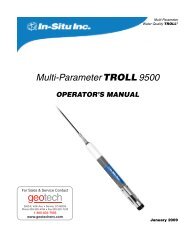TEST INSTRUCTIONS - Geotech Environmental Equipment
TEST INSTRUCTIONS - Geotech Environmental Equipment
TEST INSTRUCTIONS - Geotech Environmental Equipment
Create successful ePaper yourself
Turn your PDF publications into a flip-book with our unique Google optimized e-Paper software.
AMMONIA-NITROGEN - LOW RANGE<br />
SALICYLATE METHOD CODE 3659-01-SC<br />
QUANTITY CONTENTS CODE<br />
60 mL *Salicylate Ammonia #1 *3978-H<br />
10 g *Salicylate #2 *7457-D<br />
2x5g *Salicylate#3 *7458-C<br />
1 Spoon, 0.1 g, plastic 0699<br />
1 Spoon, 0.15 g, plastic 0727<br />
1 Pipet, 1.0 mL, plastic 0354<br />
*WARNING: Reagents marked with an * are considered hazardous substances.<br />
To view or print a Material Safety Data Sheet (MSDS) for these reagents see<br />
MSDS CD or our web site. To obtain a printed copy, contact us by e-mail,<br />
phone or fax.<br />
Ammonia nitrogen is present in various concentrations in many surface and<br />
ground water supplies. Any sudden change in the concentration of ammonia<br />
nitrogen in a water supply is cause for suspicion. A product of microbiological<br />
activity, ammonia nitrogen is sometimes accepted as chemical evidence of<br />
pollution when encountered in natural waters.<br />
Ammonia is rapidly oxidized in natural water systems by special bacterial<br />
groups that produce nitrite and nitrate. This oxidation requires that dissolved<br />
oxygen be available in the water. Ammonia is an additional source of nitrogen<br />
as a nutrient which may contribute to the expanded growth of undesirable<br />
algae and other forms of plant growth that overload the natural system and<br />
cause pollution.<br />
APPLICATION: Low concentrations of ammonia in fresh, brackish and salt<br />
water; fresh and salt water aquariums.<br />
RANGE: 0.00 - 1.00 ppm Ammonia-Nitrogen<br />
METHOD: Salicylate and ammonia react at high pH in the presence of<br />
a chlorine donor and an iron catalyst to form a blue<br />
indophenol dye, the concentration of which is proportional<br />
SAMPLE<br />
HANDLE &<br />
PRESERVATION:<br />
to the ammonia concentration in the sample.<br />
Ammonia solutions tend to be unstable and should be<br />
analyzed immediately. Samples may be stored for 24 hours at<br />
4°C or 28 days at –20°C.<br />
INTERFERENCES: There are few interferences in most natural waters. High<br />
concentrations of reducing agents, such as hydrazine, react<br />
with the chlorine donor and can result in negative<br />
interferences. Color and turbidity can also interfere.<br />
Smart2 <strong>TEST</strong> PROCEDURES 2.04 Ammonia-Nitrogen - LR 1/3

















